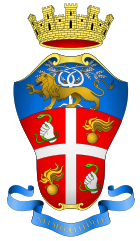
Back كارابينييري Arabic Carabinieri Catalan Karabiniéři Czech Carabinieri German Καραμπινιέροι Greek Korpuso de la Karabenistoj Esperanto Arma de Carabineros Spanish Karabinjeerid Estonian Carabinieri Basque کارابینیری Persian
| Carabinieri Arma dei Carabinieri | |
|---|---|
 Emblem | |
 Heraldic achievement | |
| Motto | Nei Secoli Fedele Faithful through the centuries |
| Agency overview | |
| Formed | July 13, 1814 |
| Jurisdictional structure | |
| National agency | Italy |
| Operations jurisdiction | Italy |
| General nature | |
| Operational structure | |
| Headquarters | Rome |
| Sworn members | 110,000 officers |
| Elected officers responsible | |
| Agency executive |
|
| Parent agency | Ministry of Defence Ministry of the Interior |
| Notables | |
| Anniversary |
|
| Website | |
| carabinieri.it | |
The Carabinieri (/ˌkærəbɪnˈjɛəri/, also US: /ˌkɑːr-/,[1][2] Italian: [karabiˈnjɛːri]; formally Arma dei Carabinieri, "Arm of Carabineers"; previously Corpo dei Carabinieri Reali, "Royal Carabineers Corps")[3][4][5][6] are the national gendarmerie of Italy who primarily carry out domestic and foreign policing duties. It is one of Italy's main law enforcement agencies, alongside the Polizia di Stato and the Guardia di Finanza. As with the Guardia di Finanza but in contrast to the Polizia di Stato, the Carabinieri are a military force. As the fourth branch of the Italian Armed Forces, they come under the authority of the Ministry of Defence; for activities related to inland public order and security, they functionally depend on the Ministry of the Interior. In practice, there is a significant overlap between the jurisdiction of the Polizia di Stato and Carabinieri, although both of them are contactable through 112, the European Union's Single Emergency number.[7] Unlike the Polizia di Stato, the Carabinieri have responsibility for policing the military, and a number of members regularly participate in military missions abroad.
They were originally founded as the police force of the Kingdom of Sardinia, the forerunner of the Kingdom of Italy. During the process of Italian unification, the Carabinieri were appointed as the "First Force" of the new national military organization. Although the Carabinieri assisted in the suppression of opposition during the rule of Benito Mussolini, they were also responsible for his downfall and many units were disbanded during World War II by Nazi Germany, which resulted in large numbers of Carabinieri joining the Italian resistance movement.
In 2000, they were separated from the Army to become a separate branch of the Italian Armed Forces. Carabinieri have policing powers that can be exercised at any time and in any part of the country, and they are always permitted to carry their assigned weapon as personal equipment (Beretta 92FS pistols).
The Carabinieri are often referred to as "La Benemerita" (The Reputable or The Meritorious) as they are a trusted and prestigious law enforcement institution in Italy. The first official account of the use of this term to refer to the Carabinieri dates back to June 24, 1864.[8]
- ^ "carabiniere" (US) and "carabiniere". Lexico UK English Dictionary. Oxford University Press. Archived from the original on 2020-03-22.
- ^ "carabiniere". Merriam-Webster.com Dictionary. Merriam-Webster.
- ^ Paoletti, Ciro (2008). A Military History of Italy. Greenwood Publishing Group. ISBN 978-0-275-98505-9.
- ^ Stone, Peter G; Bajjaly, Joanne Farchakh (2008). The Destruction of Cultural Heritage in Iraq. Boydell & Brewer Ltd. p. 235. ISBN 978-1-84383-384-0.
- ^ Richard Heber Wrightson, A History of Modern Italy, from the First French Revolution to the Year 1850. Elibron.com, 2005
- ^ A new survey of universal knowledge. Vol. 4. Encyclopædia Britannica. 1952.
- ^ "The Service". NUE 112 Numero di emergenza Unico Europeo. Retrieved 2021-07-26.
- ^ "Benemerita". www.carabinieri.it.